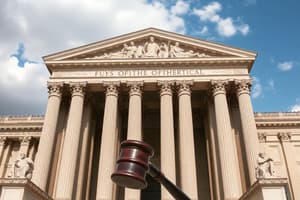Podcast
Questions and Answers
The Supreme Court's power of judicial review ________.
The Supreme Court's power of judicial review ________.
enables it to declare acts of the other branches unconstitutional
The Supreme Court most typically functions as ________.
The Supreme Court most typically functions as ________.
an appeals court
In Federalist No. 78, Alexander Hamilton characterized the judiciary as the ________.
In Federalist No. 78, Alexander Hamilton characterized the judiciary as the ________.
least dangerous
Appellate jurisdiction is defined as ________.
Appellate jurisdiction is defined as ________.
Common law is defined as ________.
Common law is defined as ________.
Original jurisdiction is defined as ________.
Original jurisdiction is defined as ________.
Marbury v. Madison is known as ________.
Marbury v. Madison is known as ________.
Judicial review is defined as ________.
Judicial review is defined as ________.
An appellate court is defined as ________.
An appellate court is defined as ________.
Civil law is defined as ________.
Civil law is defined as ________.
A trial court is defined as ________.
A trial court is defined as ________.
Criminal law is defined as ________.
Criminal law is defined as ________.
The dual court system refers to ________.
The dual court system refers to ________.
Of all the court cases in the United States, the majority are handled ________.
Of all the court cases in the United States, the majority are handled ________.
Both state and federal courts hear matters that involve ________.
Both state and federal courts hear matters that involve ________.
A state case is more likely to be heard by the federal courts when ________.
A state case is more likely to be heard by the federal courts when ________.
In standing by precedent, a judge relies on the principle of ________.
In standing by precedent, a judge relies on the principle of ________.
Besides the Supreme Court, there are lower courts in the national system called ________.
Besides the Supreme Court, there are lower courts in the national system called ________.
The justices of the Supreme Court are ________.
The justices of the Supreme Court are ________.
A synonym for circuit courts is ________.
A synonym for circuit courts is ________.
Courts of appeals/Circuit Courts are defined as ________.
Courts of appeals/Circuit Courts are defined as ________.
Stare decisis is defined as ________.
Stare decisis is defined as ________.
District courts are defined as ________.
District courts are defined as ________.
Senatorial courtesy is described as ________.
Senatorial courtesy is described as ________.
Precedent is defined as ________.
Precedent is defined as ________.
The Supreme Court consists of ________.
The Supreme Court consists of ________.
A case will be placed on the Court's docket when ________ justices agree to do so.
A case will be placed on the Court's docket when ________ justices agree to do so.
One of the main ways interest groups participate in Supreme Court cases is by ________.
One of the main ways interest groups participate in Supreme Court cases is by ________.
The lawyer who represents the federal government and argues cases before the Supreme Court is the ________.
The lawyer who represents the federal government and argues cases before the Supreme Court is the ________.
Amicus curiae literally means ________.
Amicus curiae literally means ________.
An associate justice is ________.
An associate justice is ________.
The chief justice is defined as ________.
The chief justice is defined as ________.
Flashcards are hidden until you start studying
Study Notes
Judicial Review and the Supreme Court
- Supreme Court can declare acts of other branches unconstitutional through judicial review.
- Functions primarily as an appeals court, reviewing decisions from lower courts.
- Established judicial review in the landmark case Marbury v. Madison (1803).
Types of Jurisdiction
- Appellate Jurisdiction: Allows courts to hear appeals and potentially change lower court decisions.
- Original Jurisdiction: Courts' power to hear a case for the first time.
Types of Law
- Common Law: Developed through court case rulings and judge decisions.
- Civil Law: Governs non-criminal disputes, focusing on private rights.
- Criminal Law: Defines prohibited actions harmful to others and their corresponding punishments.
Court Structures
- Dual Court System: Divides courts into federal and state systems; each state has its own courts.
- Trial Courts: First level of courts where cases are initially tried.
- District Courts: Federal trial courts where evidence is presented and cases are heard.
- Circuit/Courts of Appeals: Federal appellate courts reviewing lower court decisions.
Court Processes and Practices
- Stare Decisis: Principle of relying on precedent when making legal decisions.
- A Supreme Court case is added to the docket when four justices agree to hear it.
- Interest groups may influence cases through amicus curiae briefs, meaning "friend of the court."
Supreme Court Composition and Appointment
- Composed of one chief justice and eight associate justices.
- Justices nominated by the president and confirmed by the Senate.
- Solicitor General represents the federal government in Supreme Court proceedings.
Other Important Concepts
- Senatorial Courtesy: President consults with state senators before nominating federal judicial candidates.
- Most legal cases in the U.S. are managed at the state level.
- Both civil and criminal matters are heard in state and federal courts, with federal courts taking state cases if they involve federal questions.
- Precedent significantly influences the ongoing functioning of the judicial system.
Studying That Suits You
Use AI to generate personalized quizzes and flashcards to suit your learning preferences.




